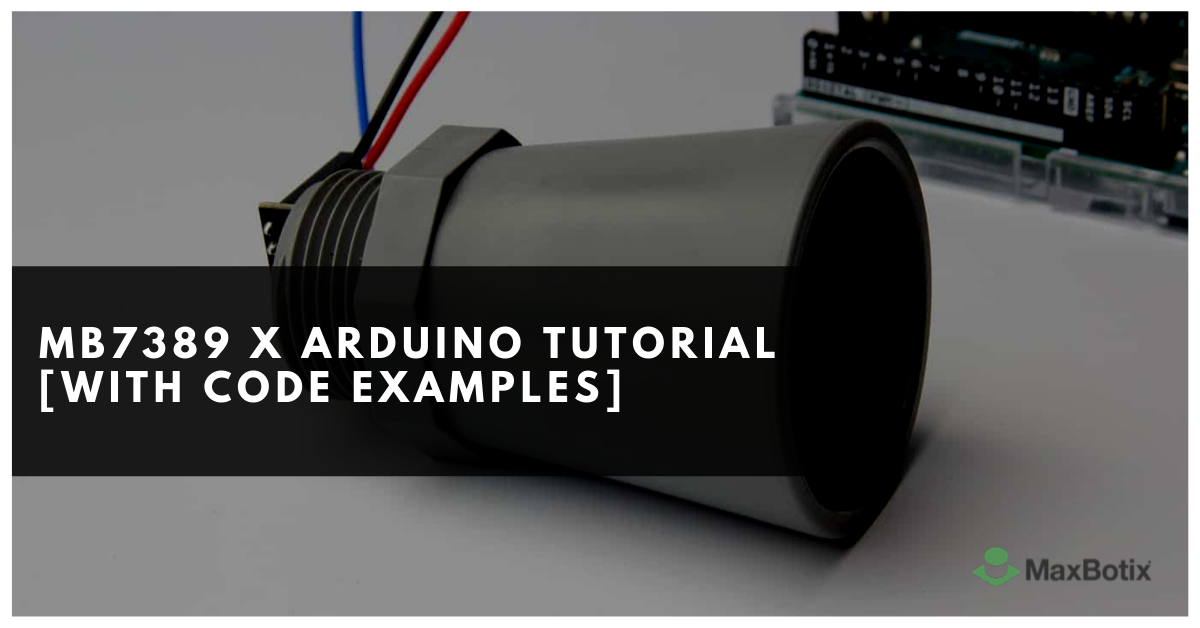Ultrasonic Sensor Arduino for Distance
Arduino Ultrasonic Distance Sensors
Many of our customers use Arduino and other micro-controllers when testing or developing their ideas.
If you’ve never tried using our sensors before, it may seem overwhelming, this guide and the others listed below will help you get started with our easy to use ultrasonic range finders.
If you need help finding the right sensor feel free to click the button “Get Help Finding the Right Sensor for Your Arduino Project” and answer 10 quick questions, so we can help you get started.
Getting Started with Arduino and MaxBotix Ultrasonic Sensors
These resources were created to help you get started working with Arduino and our sensors.
We cover:
Using an I2C-MaxSonar with an Arduino
How to Use an Ultrasonic Sensor with Arduino
MB1240 Ultrasonic Sensor with Arduino Tutorial
MB7389 Ultrasonic Sensor with Arduino Tutorial
Using an I2C-MaxSonar with an Arduino
A clear and easy path to get an I2C‑MaxSonar up and running on your Arduino.
Educational information related to this specific I2C implementation provided.
How to Use an Ultrasonic Sensor with Arduino
The MaxBotix ultrasonic sensors that interface with the Arduino platform
make it easy for users to implement ranging capabilities no matter the need.
MB1240 Ultrasonic Sensor with Arduino Tutorial
This tutorial will walk you through connecting an MB1240 Ultrasonic Sensor to an Arduino,
with code examples to get your application running.
MB7389 Ultrasonic Sensor with Arduino Tutorial
This tutorial will walk you through connecting an MB7389
weather-resistant Ultrasonic Sensor to an Arduino, with code examples.
How It Works
1. Discuss your application with our support team
2. Choose a Sensor
3. Easily integrate the sensor in your application
Collaborators
Our collaborators serve as case studies to show you how the sensors are being used in an end user application. You can either leverage our Collaborators end product or work with us to find the right sensor for your solution.
Long-range wireless IoT sensor designer and manufacturer
Radio Bridge Inc. provides a general purpose LoRaWAN bridge using MaxBotix sensors to be used in many applications.
Summary:
- Industries served: retail, industrial, oil and gas, deduction, utilities, security
- Typically used in tank monitoring applications
- Wireless connectivity with LoRaWAN protocol
- Wireless penetration through structures such as walls and floors
Ultrasonic Distance Sensor for Tank Level Measurement
LX Group developed an Ultrasonic Distance Sensor for Tank Level Measurement
Summary:
- Used in grain silos, water tanks, and dams
- Monitor the level of water tanks remotely
- The plug-and-play product works out of the box and is robustly designed to work in rough environments.
LoRaWAN IoT Distance Sensor
Sweden based company ELSYS uses a sensor from our WR line in their IoT Distance Sensor.
Real world applications include:
-
Underground water level measurement
-
Waste level measurement in containers
-
Snow depth measurement
Arduino ultrasonic sensors are at the forefront of innovative sensor technology, offering a versatile tool for various commercial operations. These sensors leverage the principles of ultrasonic waves to measure distance without direct contact, making them ideal for a wide range of industrial applications.
MaxBotix is a leader in the field of ultrasonic sensor technology. MaxBotix stands as a beacon for those seeking high-quality, reliable ultrasonic sensors for their commercial needs. Keep reading to discover how Arduino ultrasonic sensors can revolutionize your operations, with MaxBotix as your trusted partner in navigating this technological landscape.
What Are Ultrasonic Sensors?
Ultrasonic sensors work by emitting sound waves that bounce off nearby objects. The sensor calculates the time it takes for the sound waves to return, providing an accurate distance measurement. This technology is commonly used in obstacle detection, range finding, and proximity sensing.
How Ultrasonic Sensors Work with Arduino
In an Arduino project, ultrasonic sensors are connected to the microcontroller, which processes the sensor’s data to determine object distance. These sensors are ideal for projects that require non-contact distance measurement, such as:
- Obstacle avoidance in robots
- Automatic door opening systems
- Distance-based lighting control
- Parking sensors for cars
MaxBotix’s ultrasonic sensors, such as the MB1010 LV-MaxSonar-EZ1, are known for their accuracy and ease of integration into Arduino projects. With minimal setup, these sensors can start measuring distances from 6 inches to over 20 feet, providing reliable performance across a range of applications.
Advantages of Using MaxBotix Ultrasonic Sensors with Arduino
- High Precision: MaxBotix sensors offer accurate and reliable distance measurements, even in challenging environments.
- Simple Integration: They are easy to wire up and program, making them a great choice for beginners and experts alike.
- Wide Range: With different models catering to various distances and environments, MaxBotix ultrasonic sensors provide flexibility for diverse projects.
- Versatility: From basic obstacle detection to complex automation systems, MaxBotix sensors enhance any Arduino project with accurate distance-sensing technology.
Get Started with Arduino Ultrasonic Sensors
If you’re working on a robotics project or developing a smart home system, Arduino ultrasonic sensors from MaxBotix offer a precise, reliable solution. Whether you’re a hobbyist or a professional, these sensors can help you build smarter, more responsive projects.Visit the MaxBotix Arduino Ultrasonic Sensors page to explore available options and get started on your next Arduino project today!
IoT Integration for Smart Operations
One of the standout features of the Arduino Pro line is its built-in IoT wireless communication capability. These sensors can connect to various networks, including Wi-Fi, LoRa, and NB-IoT, allowing for remote monitoring and data collection. This connectivity enables industries to implement smart operations, where real-time data from sensors can be used to optimize processes, predict maintenance needs, and enhance overall efficiency.
Use Cases in Industrial Settings
The Arduino Pro sensors are ideal for a variety of industrial applications:
- Environmental Monitoring: These sensors can be used to monitor environmental parameters such as temperature, humidity, and air quality in real time, ensuring that conditions remain within safe and optimal ranges.
- Asset Tracking: With IoT capabilities, Arduino Pro sensors can track the location and status of various assets, providing updates and alerts to help manage inventory and logistics more effectively.
- Predictive Maintenance: By monitoring equipment conditions, these sensors help predict when maintenance should be performed, preventing unexpected failures and extending the lifespan of machinery.
Programming and Integration
Programming the Arduino Pro sensors for IoT applications involves setting up the device to connect to the internet and transmit data securely. Here’s a simplified example of how you might set up an Arduino Pro sensor to send data over a Wi-Fi network:
This integration of Arduino Pro sensors into industrial IoT systems not only enhances operational capabilities but also ensures that industries can leverage cutting-edge technology to remain competitive and efficient. The Arduino Pro line, with its robust design and advanced connectivity features, is transforming how industries monitor, communicate, and operate on a day-to-day basis.
Benefits of Arduino Ultrasonic Sensors
Delving deeper into the intricacies of Arduino ultrasonic sensors reveals a fascinating intersection of simplicity and sophisticated technology. These sensors harness the power of ultrasonic waves to measure distances in a way that is both innovative and accessible, thanks to the versatile Arduino platform.
Key Components and How They Work
At the heart of the Arduino ultrasonic sensor system are two critical components: the transmitter and the receiver. The transmitter emits an ultrasonic wave—a sound wave at a frequency higher than the upper audible limit of human hearing. This wave travels through the air until it hits an object and bounces back, where it is captured by the receiver. This process is facilitated by the echo and trigger pins on the sensor module.
The echo pin plays a crucial role in the process. It waits for the sound wave to be reflected back, essentially timing the duration from emission to reception. The trigger pin, on the other hand, initiates the ultrasonic pulse. By controlling these pins through an Arduino board, users can execute precise measurements of distance.
Programming for Precision
Programming Arduino ultrasonic sensors involves writing code that can accurately calculate the distance between the sensor and an object. This calculation is based on the speed of sound (approximately 343 meters per second at room temperature) and the time it takes for the ultrasonic wave to travel to the object and back to the sensor.
In an Arduino sketch, this involves setting up the trigger and echo pins as output and input, respectively. A typical void loop function might start by ensuring the trigger pin is low, then send a short, high pulse to initiate the ultrasonic burst. By measuring how long the echo pin stays high (the duration of the pulse’s round trip), the sketch can calculate the distance to the nearest object.
Applications Beyond Distance Measurement
While measuring distance is the primary function of Arduino ultrasonic sensors, their application extends far beyond that. These sensors are pivotal in robotics for obstacle avoidance, in automotive for parking sensors, and in industrial settings for monitoring liquid levels. They can also serve in interactive art installations, security systems, and a range of DIY projects that benefit from non-contact measurement.
Flexibility of the Arduino Platform
The flexibility of the Arduino platform, combined with the simplicity and efficacy of ultrasonic sensors, opens a world of possibilities for inventors, engineers, and hobbyists alike. Whether it’s automating a part of your home, creating a robot that can navigate through a maze, or developing sophisticated monitoring systems, Arduino ultrasonic sensors offer a reliable and straightforward solution.
Arduino ultrasonic sensors embody a perfect blend of accessibility and advanced technology. They empower users to build complex projects with relatively simple components, highlighting the endless possibilities within the realm of electronic innovation.
Partner with Maxbotix
To take the next step in enhancing your commercial operations with the leading-edge technology of Arduino ultrasonic sensors, we invite you to contact our team today. Let MaxBotix be your guide in navigating the world of ultrasonic sensor technology, ensuring your operations achieve new heights of efficiency and innovation.
ABOUT US
MaxBotix Inc. designs and manufactures ultrasonic sensors for use in level, proximity, and distance sensing.
CONTACT US
RESOURCES









